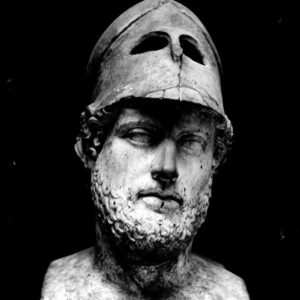Few things impact a budding art scene like an empirical power showing off. The ruling class often invest heavily in propaganda and self grandeur, paid into the hands of the artistically gifted. They might even commission a few temples, as thanks to the gods for their new found positions. The artists, as long as they celebrate approved figures, are rewarded with extravagant commissions. Their patrons, in return, shower their favorite sculptors and painters with prestige and honor.
 Pericles, the Athenian Statesman, and Alexander the Great, the king of Macedon, were no exception. In fact, the Golden Age of Athenian art – the high Classical greek art period – is broadly defined by these exceptional gentlemen, book holders for fabricated historical boundaries.
Pericles, the Athenian Statesman, and Alexander the Great, the king of Macedon, were no exception. In fact, the Golden Age of Athenian art – the high Classical greek art period – is broadly defined by these exceptional gentlemen, book holders for fabricated historical boundaries.Apparently it all started in 479 B.C. when Athens beat the Persians and founded a confederacy of allies to ensure the freedom of the Greek cities in the Aegean islands. Participants supplied either ships or funds in order to secure protection. This so-called “Delian League”, however, didn’t last long.
Athens wanted an empire, and that’s exactly what it got. First it moved the treasury closer to home – to the imperial city of Athens itself. Then the city-state put forth the Coinage Degree, which imposed Athenian silver coinage, weights and measures on all of the allies. Any left overs from the mint went straight to Athens, and any other use was punished by death.
Now the ordinary Greek members of the Delian league were, in fact, Athenian subjects.
 This is where the man who was “surrounded by glory” comes into play. Pericles, who lived from ca. 461–429 B.C., was one of the masterminds behind Athens assuming full control over the league and a famous proponent for Athenian democracy. He then orchestrated one of the greatest human embezzlements of all time. He used the league’s treasury to build some of the most amazing artistic creations of the ancient world. He launched Greek Art into the “High Classical Greek Art”.
This is where the man who was “surrounded by glory” comes into play. Pericles, who lived from ca. 461–429 B.C., was one of the masterminds behind Athens assuming full control over the league and a famous proponent for Athenian democracy. He then orchestrated one of the greatest human embezzlements of all time. He used the league’s treasury to build some of the most amazing artistic creations of the ancient world. He launched Greek Art into the “High Classical Greek Art”.Pericles transformed the Acropolis (including the Parthenon) into a lasting monument of Athens’ political and cultural power. He worked tirelessly, with the likes of the Greek sculptor Phidias, to promote Athens as the artistic center of the Ancient World.
This catalyst propelled Athens further, innovating art on every level, from theatrical works to sculpture to vases. In regards to the last item, a major development occurred in this time period. The red-figure technique superseded the previously traditional black-figure technique. This change may not, at first, seem monumental, but it allowed a greater ability to portray the human body, clothed or naked, at rest or in motion.
Meanwhile, the solid, archaic figures of early Greek sculpture transitioned into more naturalistic statues, revealing movement, grace and the female form. The nude Aphrodite of Knidos, by the Athenian sculptor Praxiteles, was one of the first to break the convention of hiding female figures behind heavily draped attire. In addition to realistic bodies, statues began to depict real people. Democracy trickled down from politics to art.
Among these changing stylistic innovations, developed the art of studying art. For the first time, artistic schools were established, such as the school at Sicyon in the Peloponnese. There students learned the cumulative knowledge of art, the foundation of art history.
It would seem as if the creative boom of the Golden Age would never end. The artistic funds of Athens, however, eventually dwindled along with Athens’ defeat in the second Peloponnesian war.
Fortunately for art, another champion came forward, along with grand commissions and an immense bank account. Alexander the Great, known for his ruthless wars and expanding empire, became a patron of the arts as never before seen… loot from plundered lands will do that. Man is seldom shy of spending other people’s money and Alexander was no different.
It is here that the artificial boundaries of history are vaguely drawn. Alexander the Great, founding great cultural cities around his empire, brought together artistic ideals which had previously never been in contact. Styles and techniques drastically changed throughout the empire’s reach. Was this the peak of Classical art or the beginning of a new age of Art? No one knows precisely when the one period ends nor when the next begins… What follows though, is the final stage of Ancient Greek art… the Hellenistic Period.
—
“High Classical Greek Art: Political Patrons” was written by Anya Leonard











2 comments
Wonderful article. Though very short, it hints at the scope for exploration in the right direction. Thanks again!
i like numbers
Trackbacks
Our apologies, you must be logged in to post a comment.